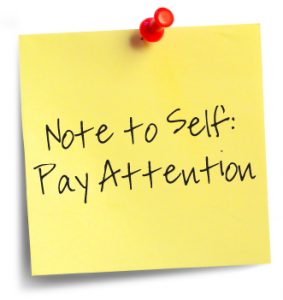 We’ve all heard the expression “Seeing is believing”. Of course, it refers to the fact that it may be hard to believe something if you haven’t seen it for yourself. That makes sense. But, there is another, similar yet contrasting expression, that also seems to be true. “Believing is seeing” refers to the idea that, if we believe something to be correct, we will only see those things that confirm what we already believe. We don’t pay much attention to any information that disputes our expectations. What you see in a situation will be influenced by your preconceived beliefs about what will be there.
We’ve all heard the expression “Seeing is believing”. Of course, it refers to the fact that it may be hard to believe something if you haven’t seen it for yourself. That makes sense. But, there is another, similar yet contrasting expression, that also seems to be true. “Believing is seeing” refers to the idea that, if we believe something to be correct, we will only see those things that confirm what we already believe. We don’t pay much attention to any information that disputes our expectations. What you see in a situation will be influenced by your preconceived beliefs about what will be there.
In psychology, this is referred to as confirmation bias. Confirmation bias is the tendency that people have to look for, interpret, and remember information that supports the attitudes that they already hold, and ignore information that goes against what they already believe. Confirmation bias affects how we see the world around us, and by extension, how we see ourselves. It explains why, many times, two people can be exposed to the same thing, but see it differently depending on what they already believe. Or a single person can see the same thing differently at different times, depending on their viewpoints at each time.

When you are falling in love and believe that this is the right person for you, you see your partner and their characteristics as attractive, positive and appealing – everything that you want in a mate. If the relationship then fails and your thoughts about this person change, you see all sorts of flaws – their messy habits, their coffee breath, their tendency to talk on and on about things you don’t really care about. Same person – different perception based on what you believe at the time.

 If you are feeling insecure about a presentation you are giving, you might see the smile that a classmate is giving you as a smirk, as someone laughing at you, whereas, if you are feeling confident and comfortable, the same smile may be interpreted as a sign of encouragement.
If you are feeling insecure about a presentation you are giving, you might see the smile that a classmate is giving you as a smirk, as someone laughing at you, whereas, if you are feeling confident and comfortable, the same smile may be interpreted as a sign of encouragement.  If you decide to join an aerobics class, your insecurities may lead you to see other people laughing at you or the instructor giving you a questioning look, as if to say “what are you doing here?”. A confident member of an aerobics class would likely see neither of those things.
If you decide to join an aerobics class, your insecurities may lead you to see other people laughing at you or the instructor giving you a questioning look, as if to say “what are you doing here?”. A confident member of an aerobics class would likely see neither of those things.
Our world is a very complicated place. It is a lot of work to sort through all of the information out there in order to come to a conclusion about what is going on each time we find ourselves involved in something new. It is easier, and more comfortable, to just notice a few things that confirm what we already believe. In fact, a surprising research finding has been that, even if the feedback is negative, we prefer it to positive information, if it aligns with what we already think.
This shortcut, seeing what we already believe, may help us to sort through the overwhelming amount of information that we face every day. It does not, however, help those people who have negative self-views to feel better about themselves . The person with low self-esteem, who doesn’t see them self as measuring up to their peers, will never change this low opinion of them self if they don’t notice those things that might challenge their negative thoughts. The person who believes they are not a good student because of some low grades won’t change that idea unless they start to pay attention to all the academic things that they do well on, like good grades in some courses, enjoyment of doing research or giving presentations, hard work or class participation.

Negative beliefs about yourself can cause problems in your life, leaving you prone to anxiety or depression, and preventing you from taking on new challenges. So what can you do?
- Our negative views may be so automatic that we don’t even notice them. To change anything, you
 first need to identify it. You need to pay attention to what you are saying to, and how you are feeling about, yourself.
first need to identify it. You need to pay attention to what you are saying to, and how you are feeling about, yourself. - Once you are aware of your thinking and feelings, you need to consider whether those thoughts are accurate and whether they are fair. After all, thoughts and feelings are only that, they are not necessarily true facts. There are many different thoughts that you can have (the sky is green, elephants can fly), but that doesn’t mean they are true.
 When you notice that you are feeling upset in some way, try to figure out what thoughts may have contributed to it. Then make a point of challenging the thoughts, by looking for and paying attention to (i.e., seeing) any contrary evidence, large or small. Don’t just let your beliefs determine what you see. Make a point of trying to find other possibilities that can help you to change those negative views about yourself.
When you notice that you are feeling upset in some way, try to figure out what thoughts may have contributed to it. Then make a point of challenging the thoughts, by looking for and paying attention to (i.e., seeing) any contrary evidence, large or small. Don’t just let your beliefs determine what you see. Make a point of trying to find other possibilities that can help you to change those negative views about yourself.- While it may be difficult to immediately replace one belief (e.g., I’m totally useless) with the opposite (I’m incredibly valuable), you can re-phrase your thought as “I feel totally useless”. This can help you to recognize that this is a feeling, not necessarily a fact. A feeling is less definite and clear-cut than a fact.
- Realize that this is a process that will take time. Perhaps, writing things that weaken your negative belief in a journal every day can help support the process, as well as keeping track of things that you are proud of, or grateful for.

Take care, and make it a point to see all of the good things that there are about you.
Rhonda Gilby
This blog is not a substitute for psychological counselling. If you do feel that you are currently in a situation in which you could use some additional help with issues that you are dealing with, please check out the resources presented here.

